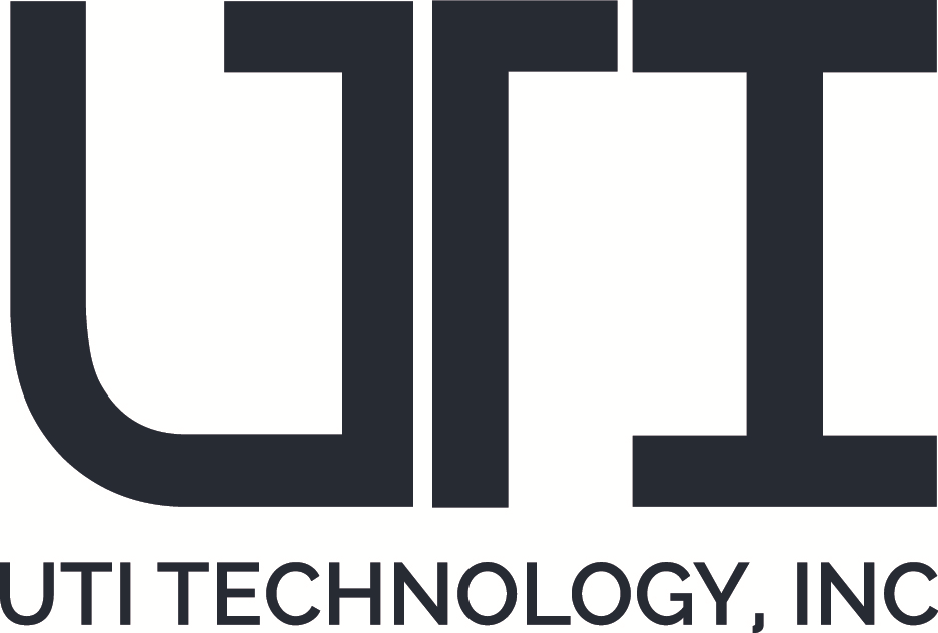Ruggedness
UTimages understands the need for ruggedness and uninterrupted productivity when it comes to operating in challenging environments. Our rugged, mobile tablets, handhelds, and fixed-mount displays increase operational efficiencies, integrate seamlessly into the enterprise, and deliver low-cost reliability for data collection and communications.
Whether tracking a fleet, mapping a mine, or monitoring equipment and production on an oil rig, UTimages provides a variety of rugged form factors with flexible options for connectivity, and data collection and management.
UTimages's rugged mobile solutions are built to withstand the rigors of the harshest environments and every product undergoes the scrutiny of two standards: the Ingress Protection (IP) rating system and the United States Military Standard Environmental Engineering Considerations and Laboratory Tests Standard (MIL-STD). Our rugged mobile devices are built to last, reducing the total cost of ownership over time.
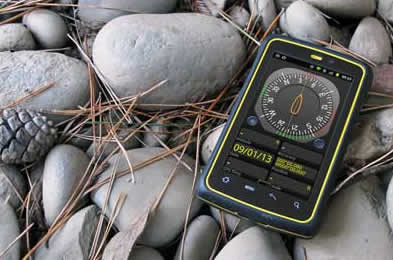
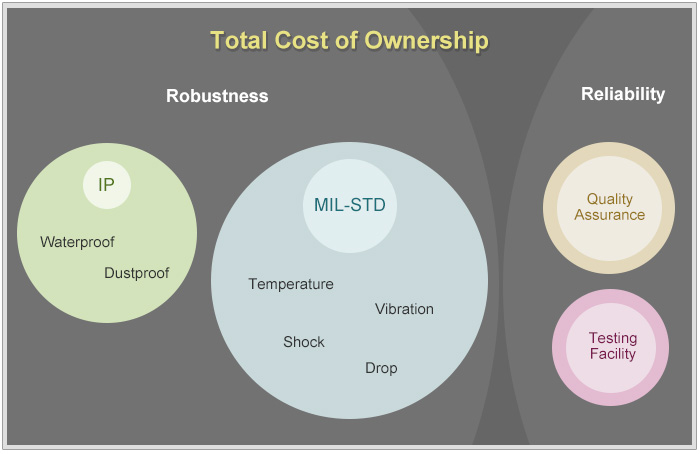
Total Cost of Ownership (TCO)
Consumer grade products with their lower initial cost may seem to be the more attraction option for enterprise and businesses for their computing need. However, one can do a simple analysis of total cost of owership (TCO) to reveal that consumer grade products can end up costing the enterprise and business much more. Considering the computing needs of enterprise and businesses, the cost of devices is not just the initial purchase cost, but we also need to examine the cost of operation and most importantly, cost of failures.
Factors such as using the computing devices under direct sunlight exposure (which require high brightness panel), with wet or gloved hands (which requires input button or digitizer), and etc, all impact the TCO. According to VDC research 2013, Environments or scenarios common to user most recent mobile deployment by form factor are listed as follows:
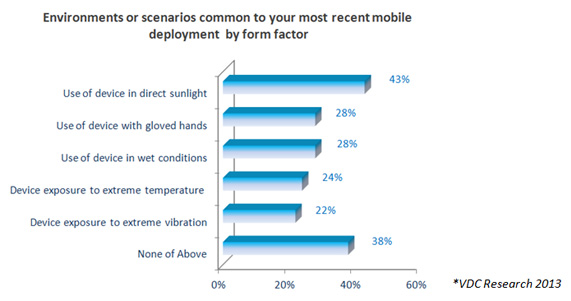
After exposing mobile devices in harsh environment there will be different variety of hardware and software issues that will lead to cost of failures such as:

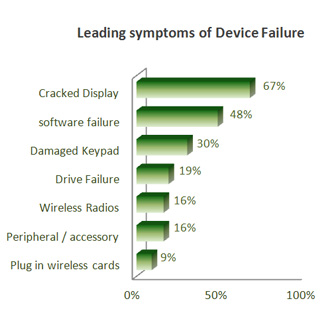
Each non-rugged device failure can cost an organization in upwards of 200 minutes of labor including productivity loss, IT support, diagnosis & time required to replace and redeploy, this failure rates of non-rugged device was a leading contributor to TCO. This business interruption is detrimental in terms of cost and also continual operation. To address the harsh environment as well as Low TCO, for example:
| High brightness panel for outdoor use |
| Physical keypad / stylus for rapid data entry while gloves on |
| IP65 up to IP67 for water and dust proof |
| Wide range operating temperature e.g. up to -20℃ ~ 60℃ |
| Compliant with MIL-STD-810F for shock , drop and vibration |
When it comes to selecting one device or hundred devices for mobile deployments, Rugged Mobile Computing devices offer greater enterprise value and provide low TCO.
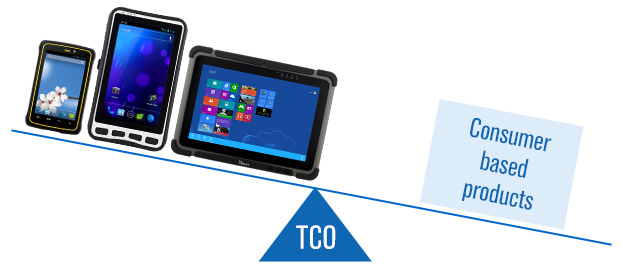
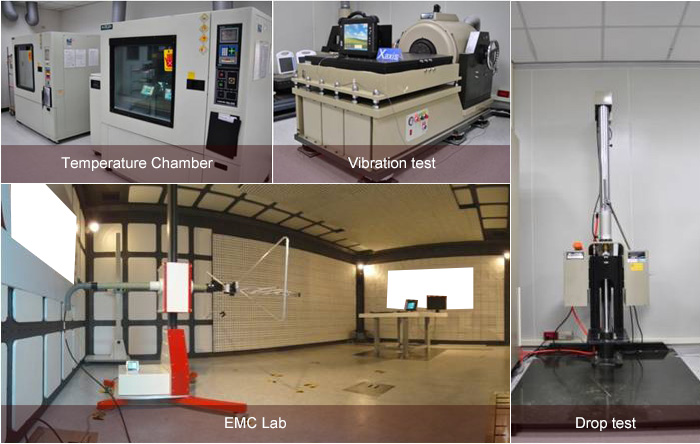
MIL-STD810F/G
The MIL-STD-810 test series are approved for use by all departments and agencies of the United States Department of Defense (DoD). MIL-STD-810 addresses a broad range of environmental conditions that include: low pressure for altitude testing; exposure to high and low temperatures plus temperature shock (both operating and in storage); rain (including wind blown and freezing rain); humidity, fungus, salt fog for rust testing; sand and dust exposure; explosive atmosphere; leakage; acceleration; shock and transport shock; gunfire vibration; and random vibration. The standard describes environmental management and engineering processes that can be of enormous value to generate confidence in the environmental worthiness and overall durability of a system design.
MIL-STD810F/G
The MIL-STD-810 test series are approved for use by all departments and agencies of the United States Department of Defense (DoD). MIL-STD-810 addresses a broad range of environmental conditions that include: low pressure for altitude testing; exposure to high and low temperatures plus temperature shock (both operating and in storage); rain (including wind blown and freezing rain); humidity, fungus, salt fog for rust testing; sand and dust exposure; explosive atmosphere; leakage; acceleration; shock and transport shock; gunfire vibration; and random vibration. The standard describes environmental management and engineering processes that can be of enormous value to generate confidence in the environmental worthiness and overall durability of a system design.
| MIL-STD-810 Method 501.4 | High Temperature |
| MIL-STD-810 Method 502.4 | Low Temperature |
| MIL-STD-810 Method 507.4 | Humidity |
| MIL-STD-810 Method 514.5 | Vibration |
| MIL-STD-810 Method 516.5 | Shock |
MIL-STD461E/F
MIL-STD-461 is a United States Military Standard that describes how to test equipment for electromagnetic compatibility. Specifically, MIL-STD 461F details testing specification to ensure the conducted emissions (CE), conducted susceptibility (CS), radiated emissions (RE), and radiated susceptibility (RS) of a system can meet the requirements for the control of electromagnetic interference.
| MIL-STD-461 Method - CE101 / CE102 | Conducted Emissions |
| MIL-STD-461 Method - CS101 / CS106 / CS109 / CS114 / CS115 / CS116 | Conducted Susceptibility |
| MIL-STD-461 Method - RS101/RS103 | Radiated Susceptibility |
| MIL-STD-461 Method - RE101 / RE102 | Radiated Emissions |
Test Items:
. CE102
. RE102
UTImage offers rugged products that provide various levels of mechanical IP dust and water resistant design, and our products all went though extended amount of MIL-STD testing to ensure high standards of reliability and robustness withstanding shock and vibration tolerance, survival of high temperature, and corrosive environments.
Ingress Protection (IP)
International Protection Rating consists of the letters IP followed by two digits or one digit and one letter and an optional letter. As defined in international standard IEC 60529, IP Code classifies and rates the degrees of protection provided against the intrusion of solid objects (including body parts like hands and fingers), dust, accidental contact, and water in mechanical casings and with electrical enclosures. The standard aims to provide users more detailed information than vague marketing terms such as waterproof.
| IP First number - Protection against solid objects |
|
|---|---|
| 0 | No special protection |
| 1 | Protected against solid objects over 50 mm, e.g. accidental touch by persons hands. |
| 2 | Protected against solid objects over 12 mm, e.g. persons fingers. |
| 3 | Protected against solid objects over 2.5 mm (tools and wires). |
| 4 | Protected against solid objects over 1 mm (tools, wires, and small wires). |
| 5 | Protected against dust limited ingress (no harmful deposit). |
| 6 | Totally protected against dust. |
| IP Second number - Protection against liquids |
|
|---|---|
| 0 | No protection. |
| 1 | Protection against vertically falling drops of water e.g. condensation. |
| 2 | Protection against direct sprays of water up to 15o from the vertical. |
| 3 | Protected against direct sprays of water up to 60o from the vertical. |
| 4 | Protection against water sprayed from all directions - limited ingress permitted. |
| 5 | Protected against low pressure jets of water from all directions - limited ingress. |
| 6 | Protected against temporary flooding of water, e.g. for use on ship decks - limited ingress permitted. |
| 7 | Protected against the effect of immersion between 15 cm and 1 m. |
| 8 | Protects against long periods of immersion under pressure. |
